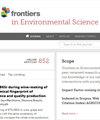Assessment of the physicochemical properties of the sediment from the Gangetic floodplain wetlands of West Bengal, India, with GIS and a statistical approach
IF 3.3
3区 环境科学与生态学
Q2 ENVIRONMENTAL SCIENCES
引用次数: 0
Abstract
IntroductionBottom sediments play a pivotal role in wetland productivity, and here, eight Gangetic floodplain wetlands of India were studied to assess the sediment physicochemical characteristics and textural analysis.MethodsSediment samples that were collected from each wetland in monsoon and non-monsoon seasons were analysed. ANOVA, Principal component analysis and multiple correlation analysis were used for statistical analysis.Results and DiscussionThroughout the study period, pH (6.90–8.04), EC (0.20–1.64 dS/m), CaCO利用地理信息系统和统计方法评估印度西孟加拉邦恒河洪泛平原湿地沉积物的物理化学特性
引言底层沉积物在湿地生产力中发挥着关键作用,本文研究了印度恒河洪泛平原的 8 个湿地,以评估沉积物的物理化学特征和质地分析。方法分析了在季风和非季风季节从每个湿地采集的沉积物样本。结果与讨论在整个研究期间,pH 值(6.90-8.04)、EC 值(0.20-1.64 dS/m)、CaCO3(1.75%-14.50%)、可利用氮(10.22-22.23 毫克/100 克沉积物)、总氮(80.4-333.8 毫克/100 克沉积物)、可利用磷(0.20-5.61 毫克/100 克沉积物)和总磷(19.63-173.33 毫克/100 克沉积物)。不同湿地的沉积物质量参数差异很大(p> 0.05)。仅在总氮和总磷含量方面观察到季节性变化。沉积物以沙子为主。湿地沉积物养分(C、N 和 P)的化学计量学显示,C/P(5.96-66.32)比值相对较高,C/N(3.34-22.76)和 N/P(1.12-9.25)比值较低,这表明沉积物的物理化学特征受到人为来源的影响。主成分分析表明了自然和人为原因对湿地生态系统的影响。地理信息系统(GIS)插值法与实验室分析方法相结合,对每个湿地的沉积物质量进行了完整的空间解析。研究表明,这些湿地的沉积物质量有利于鱼类养殖,但需要适当的管理方法才能实现可持续生产。由于这是首次对这些湿地沉积物的物理化学特性进行监测,因此这项研究可作为基线数据,供今后对湿地进行环境评估时进行比较。
本文章由计算机程序翻译,如有差异,请以英文原文为准。
求助全文
约1分钟内获得全文
求助全文
来源期刊

Frontiers in Environmental Science
Environmental Science-General Environmental Science
CiteScore
4.50
自引率
8.70%
发文量
2276
审稿时长
12 weeks
期刊介绍:
Our natural world is experiencing a state of rapid change unprecedented in the presence of humans. The changes affect virtually all physical, chemical and biological systems on Earth. The interaction of these systems leads to tipping points, feedbacks and amplification of effects. In virtually all cases, the causes of environmental change can be traced to human activity through either direct interventions as a consequence of pollution, or through global warming from greenhouse case emissions. Well-formulated and internationally-relevant policies to mitigate the change, or adapt to the consequences, that will ensure our ability to thrive in the coming decades are badly needed. Without proper understanding of the processes involved, and deep understanding of the likely impacts of bad decisions or inaction, the security of food, water and energy is a risk. Left unchecked shortages of these basic commodities will lead to migration, global geopolitical tension and conflict. This represents the major challenge of our time. We are the first generation to appreciate the problem and we will be judged in future by our ability to determine and take the action necessary. Appropriate knowledge of the condition of our natural world, appreciation of the changes occurring, and predictions of how the future will develop are requisite to the definition and implementation of solutions.
Frontiers in Environmental Science publishes research at the cutting edge of knowledge of our natural world and its various intersections with society. It bridges between the identification and measurement of change, comprehension of the processes responsible, and the measures needed to reduce their impact. Its aim is to assist the formulation of policies, by offering sound scientific evidence on environmental science, that will lead to a more inhabitable and sustainable world for the generations to come.
 求助内容:
求助内容: 应助结果提醒方式:
应助结果提醒方式:


